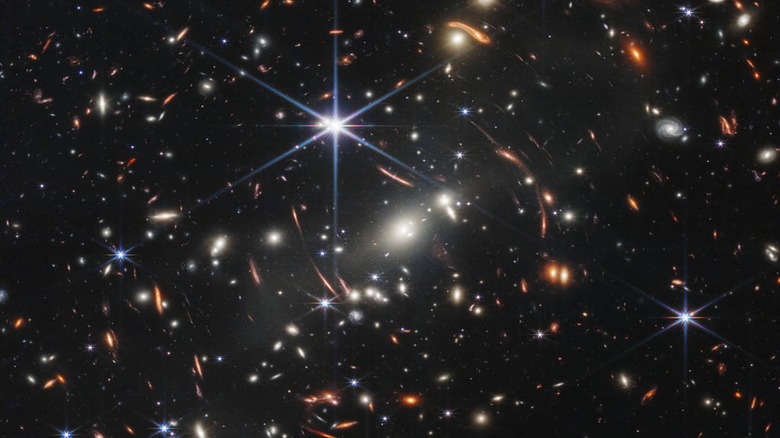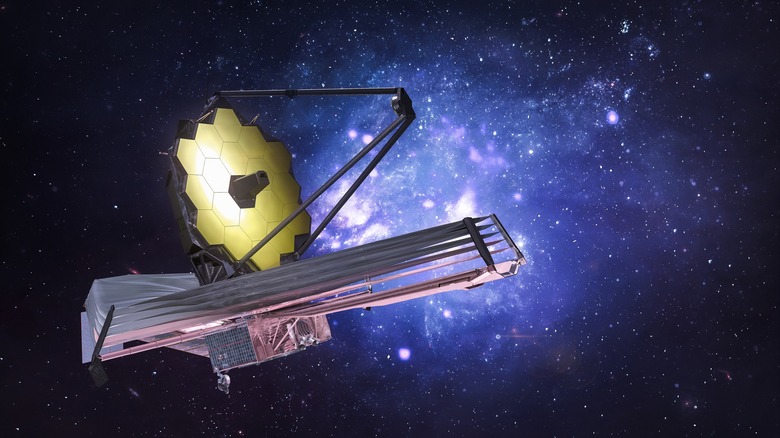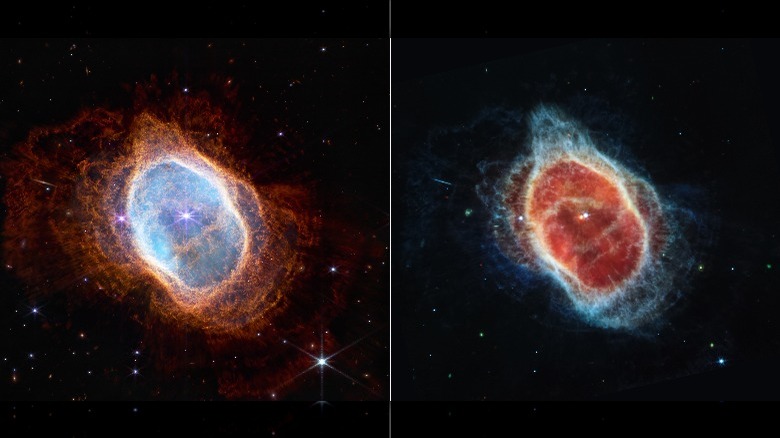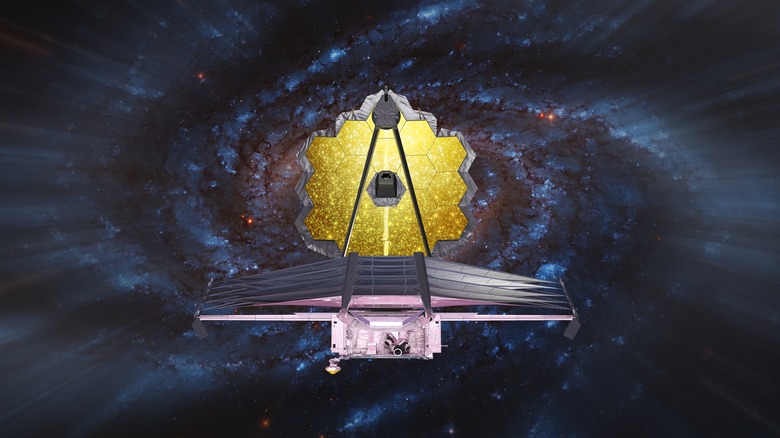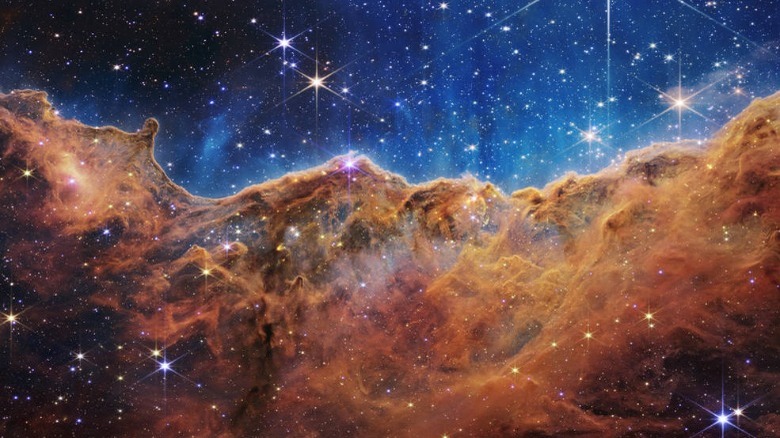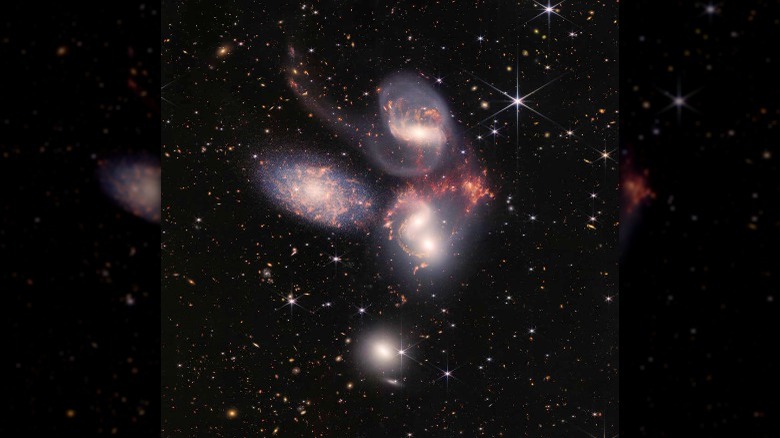Images From The James Webb Space Telescope Versus Hubble Are Out Of This World
Every so often, a new image from deep space is released to the public and subsequently becomes headline news. In 2019, the Event Horizon Telescope (EHT) radio telescope network captured a jaw-dropping image of the shadow of a supermassive black hole, located 55 million light years away in the Messier 87 galaxy (via NASA). The image broke new ground in offering a direct scientific representation of a phenomenon that up until that point had been theoretical and visualized only through artists' impressions. It was published on dozens of mainstream news websites and featured prominently in non-scientific newspapers and magazines around the world.
And in July 2022, NASA published the incredible image above — one of the first to be taken by the agency's $10 billion cutting-edge James Webb Space Telescope. Called simply 'Webb' by astronomers and known as the successor — NASA says they prefer that term to the commonly used "replacement" — to the Hubble telescope, Webb's first images have been long anticipated. Unveiling the startling new images, President Joe Biden declared the telescope's first success to be "a historic moment ... for America and all of humanity" (via The Guardian).
Webb vs. Hubble
While the Hubble Telescope was launched in 1990, having been sent into space via NASA's space shuttle, Hubble only became operational in 1993, after it was found that a minute flaw in the telescope's mirror meant that it would not offer sharp imaging and it would have to be repaired. In the decades that followed, Hubble provided some of the most breathtaking images of the cosmos ever thought possible. Webb's launch in December 2021 was equally precarious. As the official Webb Telescope website notes, the telescope's destination was well beyond the range at which maintenance would be possible, and if there were any faults there would be no way to correct them. However, Webb safely reached its required orbit in January 2022, and began collecting its first images.
Webb differs from Hubble in two significant ways. Per NASA, Webb is designed primarily to observe space phenomena in infrared, allowing the telescope to detect a far greater number of stars and planets than Hubble, which focused primarily on the visible and ultraviolet parts of the spectrum. And whereas Hubble is in orbit at 570 km (354 miles) above the surface of the Earth, Webb is far further out: 1.5 million km (1 million miles) from us, around four times farther than the distance to the moon.
Webb also outperforms Hubble in terms of raw power. "Webb is bigger than Hubble so that it can see fainter galaxies that are further away," said NASA deputy senior project scientist Jonathan Gardner (per The Guardian).
The first Webb image
The first James Webb Space Telescope images released by NASA have caused a great deal of excitement in the scientific community and beyond. And if anything, the image of SMACS 0723 galaxy cluster becomes all the more impactful once you learn the details of what it represents and what it means for what the telescope might reveal in years to come.
Per NASA, the incredibly detailed image, which features numerous whole galaxies in a cluster called SMACS 0723, is the equivalent of a portion of the night sky the size of a single grain of sand held at arm's length.
"It's exhilarating to see the fantastic James Webb Space Telescope image released today," as University College London's Richard Ellis, an astrophysicist who had a guiding hand in the Webb project, told The Guardian. "As we are ourselves made of the material synthesized in stars over the past 13 billion years, [Webb] has the unique ability to trace back to our own origins in this remarkable universe. Everyone can take part in this amazing adventure." More images released by NASA have included the deaths of stars (pictured), captured in exquisitely sharp detail.
Peering into the past
As Ellis notes, the scale at which the James Webb Space Telescope is making its observations of the universe means that we are in line for some truly mind-blowing findings. In fact, it is not entering the realm of fantasy to consider Webb as a kind of time machine, allowing us to peer into the distant past.
With the use of its cutting-edge Mid-Infrared Instrument (MIRI) and its Near-Infrared Camera (NIRCam), which build composite images made up of images collected across a range of wavelengths over the course of more than 12 hours — Hubble's far-less detailed image of the same area, NASA notes, took several weeks — reveals galaxies far too distant and faint for previous technology to pick up.
The greater the distance an object is from Earth — or, in this case, the James Webb Space Telescope — the greater the amount of time that the light has traveled. In the case of the SMACS 0723 just received from Webb, this means that we are observing galaxies as they would have been many billions of years ago.
A future Cosmic Dawn
The repercussions for this in terms of what scientists are actually observing when they receive images from the James Webb Space Telescope are staggering. As NASA explains, the more powerful and well-placed a telescope is and the deeper into the universe it can see, meaning that as Webb's work continues the telescope will begin to look further back in time than any human technology has looked before. Webb's capabilities are estimated to allow the telescope to look back more than 13 billion years, to within 0.3 billion years of the Big Bang. In doing so, Webb will be able to see the formation of the very first stars and galaxies in the universe, just as they come into existence following the period immediately following the Big Bang, known as the Dark Age.
And Webb isn't just expected to give us new insights into the origins of the universe. As noted by Space.com, the incredible detail of the images the telescope shall return to us will aid dramatically in the search for other habitable planets apart from Earth, and raises the tantalizing possibility of the detection of extraterrestrial life.
All eyes on space
In the days following the release of the first images of the SMACS 0723 galaxy cluster from the James Webb Space Telescope, NASA unveiled dozens more stunning close-ups of deep space phenomena, including the Carina Nebula as well as the five-galaxy cluster named "Stephan's Quintet" (pictured), an image recognizable to many of us thanks to its use in the movie "It's A Wonderful Life."
But Webb isn't the only piece of new technology scanning the skies for thought-provoking scientific discoveries in the coming years. The Extremely Large Telescope (ELT) — previously known as the European Extremely Large Telescope (E-ELT) — is another major telescopic project, begun in 2017 and due for completion in 2024 (per Universe Today). According to the University of Oxford, the primary mirror of the telescope is planned to be 39 meters (128 ft) in diameter, making it the largest telescope on the surface of the Earth. Though it will not be launched into space as the James Webb Space Telescope and Hubble Telescope were, the ELT is highly anticipated by scientists, who argue that it too will examine the Dark Ages of the Universe, search for life, and help answer questions about theoretical particles, such as dark matter.
